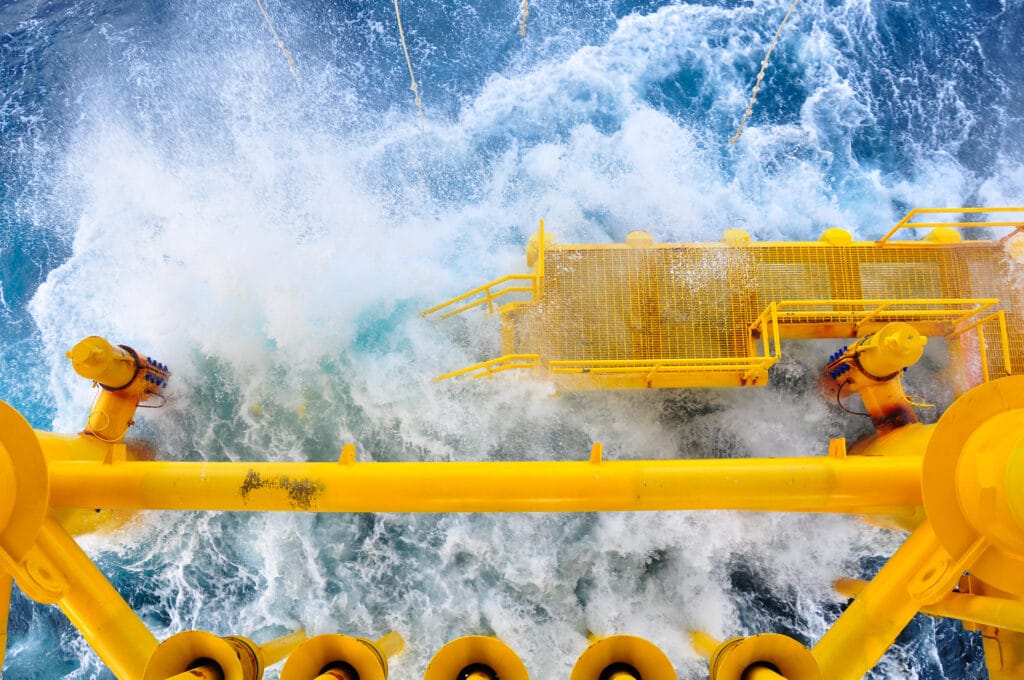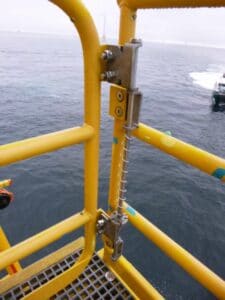Imagine your journey to work was so dangerous that there are 20-page guidance documents to ensure you get there safely.
This is the reality for offshore wind farm maintenance engineers. But why is it so dangerous?
Harsh conditions

Engineers commonly access wind turbines on crew transfer vessels (CTVs). The weather conditions out on open sea where the platforms are located, can be unpredictable. High waves are thus likely to rock the CTV during a transfer, complicating a safe completion. To help make the transfer safer, it needs to be as easy and quick as possible.
As a result, gates and railings sometimes aren’t fitted around the landing platforms. Limiting the steps engineers have to go through is one way of aiding a smooth transfer. But not having any gates or railings on the platforms has the obvious risks of falling and going overboard.
When gates are used, they are either fitted with a simple latch mechanism or a magnet. These are used to ensure that the gate is kept shut during the high winds that occur on these platforms.
In some situations, neither of these solutions will be suitable. Depending on the design, a latch mechanism can be difficult to open quickly enough for the engineers during transfer and magnets often corrode in the harsh marine conditions.
What is the solution?

Instead of using a complicated latch or an unsuitable magnet, we wanted to explore the possibility of using our spring assisted self-closing hinges to ensure the gate is held closed at all times but can be easily opened during transfer.
The challenge with this lies in achieving a balance between the spring tension needed to hold the gate closed in the high winds, while still ensuring the push force isn’t too high for operators to open during transfer.
Our engineers have been working on modifying our existing design to test this theory while keeping this challenge in mind.
Spring vs max wind force
The first challenge is determining if a spring can be used to close the gate against the max wind force experienced. Boat access platforms can experience winds that reach over 35 m/s.
After testing multiple spring designs and strengths, we were able to determine that a spring closer can indeed be used to close and keep gates closed in these conditions.
The tests were based on using a typical offshore aluminium gate design that would commonly be used on boat access platforms. The tests showed that the spring needed to exert a force of 0.45kN on the gate to be able to keep it closed during high winds.
According to an assessment by HSE, the maximum recommended pushing force for men is around 200 Newtons (0.2kN) and 150 Newtons (0.15kN) for women.
The closing force of 0.45kN required to close the gate would therefore mean the gate is dangerously difficult to open and it would not be suitable for use on a boat access platform.
Next steps
To make a spring assisted self-closing hinge work on a boat access platform, we need to find and fine-tune the balance between usability and strength of closing. The next steps will therefore be to see if this balance can be achieved with further testing and prototyping.
In addition to this, another challenge is when wind and waves hit a certain level, the engineers won’t be accessing the turbines due to health and safety risks. It is crucial to ensure that the springs will still be able to keep the gates closed in these tougher conditions. The self-closing hinges could be used in conjunction with a simple hold closed latch that can be quickly and easily operated when engineers are accessing the turbines.
Another option one might consider is to let the gate open and close as it will in harsh conditions, however, this comes with obvious risks to adjacent railings. It would also put large forces on the gate hinge parts meaning they wear quicker and will most likely need replacements more often.
Our engineers and designers are now looking into these different alternatives and testing them to find the best one. This is the sort of challenges we love to work on solving together with our clients. Ultimately, the goal of our testing is to help platform designers make crew transfers to offshore platforms as safe and efficient as possible.
Get in touch to hear more about how we can help you make offshore platforms safer with the right gate hardware.
Call: +44 (0) 1243 558 580
E-mail: info@gatemasteroffshore.com